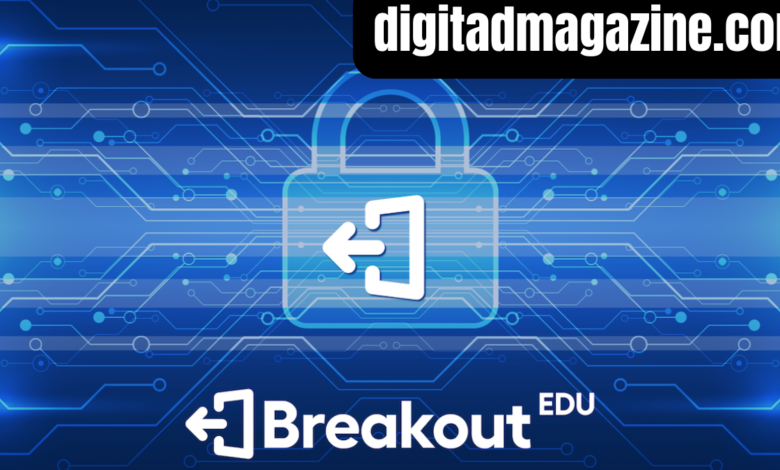Breakout EDU: Revolutionizing Education with Interactive Learning

Introduction
In the ever-evolving landscape of education, engaging students in meaningful and effective ways has always been a challenge for educators. Breakout EDU is one of the most innovative tools that has emerged in recent years, offering a fun and interactive approach to learning. But what exactly is Breakout EDU? Simply put, it’s a type of educational game that uses the concept of escape rooms to create immersive learning experiences. Whether physical or digital, these games require students to solve puzzles, decipher clues, and work together to unlock a series of challenges.
The popularity of Breakout EDU is rooted in the shift towards interactive learning methods. Traditional lectures and textbook-based instruction are being complemented by hands-on, problem-solving activities that foster collaboration and critical thinking. Breakout EDU games align perfectly with this shift, offering students a chance to actively engage in their learning process while having fun. As more schools adopt this method, Breakout EDU is proving to be more than just a passing trend—it’s a transformative educational tool.
What is Breakout EDU?
Breakout EDU was initially inspired by escape room experiences—physical spaces where participants are given a series of clues to solve puzzles and escape before time runs out. In an educational setting, Breakout EDU adapts this format to create challenging yet enjoyable learning activities that promote teamwork and critical thinking. The objective of each game is for students to solve a series of interconnected puzzles and unlock a “box” or “lock” to complete the challenge.
The game can be either physical or digital, and both have their own unique advantages. Physical Breakout EDU experiences typically involve a locked box, puzzles, and clues that need to be physically manipulated by the students. On the other hand, digital Breakout EDU experiences are typically run on a computer or tablet and use a series of online puzzles and interactive elements to engage students.
The beauty of Breakout EDU lies in its versatility. These games can be adapted for students of all age groups, from elementary school children to high school students, and even college-level learners. There are also pre-designed games available for various subjects, including math, history, science, and language arts, making it easy for teachers to incorporate into their lessons.
How Breakout EDU Enhances Learning
Breakout EDU is not just about fun; it’s about creating an enriching educational experience. The games are designed to enhance a wide variety of learning outcomes. One of the most notable benefits is the promotion of teamwork. In a typical Breakout EDU session, students must collaborate to solve the puzzles. This builds important skills such as communication, negotiation, and cooperation, all of which are critical in both academic and real-world settings.
In addition to fostering teamwork, Breakout EDU challenges students’ problem-solving abilities. The puzzles are designed to require critical thinking and creativity, prompting students to analyze the information presented and make connections that may not be immediately obvious. This aligns with modern educational theories, which emphasize the importance of developing higher-order thinking skills. Moreover, the hands-on, interactive nature of the game makes learning more engaging, allowing students to take a more active role in their education.
Breakout EDU is also highly adaptable to various subjects. For example, math-related Breakout EDU games might involve puzzles that require students to solve equations or decipher patterns, while history-based games may present historical events that need to be connected. The ability to seamlessly integrate this tool into any subject allows teachers to bring new excitement into topics that might otherwise seem dry or difficult.
Step-by-Step Guide to Implementing Breakout EDU in Your Classroom
Implementing Breakout EDU in your classroom may sound like a complex task, but it can be broken down into manageable steps. First, teachers should set clear objectives for the activity. What specific skills or knowledge do they want students to develop through the game? Whether it’s teamwork, critical thinking, or mastering a particular academic concept, the objective should guide the creation of the puzzles and the flow of the game.
Next, it’s time to choose the right Breakout EDU game for your class. There are many pre-designed games available, but teachers can also create their own. Teachers should consider the age group and learning level of their students when selecting or designing games. For younger students, simple puzzles with straightforward solutions might be appropriate, while older students can tackle more complex, multi-layered challenges. Additionally, consider whether a physical or digital version of the game would be more suitable for your classroom setup.
Setting up the game itself involves preparing the materials, whether that means hiding physical clues around the room or setting up digital puzzles on tablets or computers. Teachers can also design their own clues and puzzles using online tools and templates. Running the game is the next step. It’s important to provide clear instructions to the students and make sure they understand the rules of the game. Teachers should also ensure that they are actively guiding the students through the activity, providing hints when necessary, and maintaining a supportive environment.
After the game is complete, debriefing is crucial. Discussing what worked well and what could have been improved allows students to reflect on their problem-solving strategies and learn from the experience. This final step helps solidify the educational benefits of the activity and enhances the learning outcomes.
Challenges and Best Practices for Using Breakout EDU in Education
While Breakout EDU is an exciting and valuable learning tool, it’s not without its challenges. One of the biggest hurdles that teachers face is the time and effort required to prepare the games. Designing puzzles, setting up the materials, and ensuring the game runs smoothly can be time-consuming, especially for teachers who are already stretched thin with other responsibilities. To combat this, teachers can use pre-designed games or collaborate with colleagues to share resources and ideas.
Another challenge is managing diverse learner needs. Students in the same classroom may have varying levels of prior knowledge, different learning styles, or varying levels of engagement. It’s important for teachers to design games that are flexible and inclusive, ensuring that all students can participate and benefit from the experience. Teachers can also adapt games to suit different learning levels, ensuring that the puzzles are appropriately challenging for each student.
One best practice is to encourage student feedback after each game. This feedback can help teachers understand what worked well and what could be improved for future sessions. Additionally, teachers can modify the game based on student input to keep it engaging and relevant. For example, if students express interest in a particular subject, teachers can design Breakout EDU games that incorporate that topic, keeping the games fresh and exciting.
Conclusion
Breakout EDU is more than just a fun classroom activity—it’s a powerful educational tool that fosters collaboration, creativity, and critical thinking. By using Breakout EDU games, teachers can provide an immersive learning experience that engages students in meaningful ways. These games offer a dynamic approach to traditional learning methods, enabling students to take charge of their education while working together to solve real-world problems.
As more educators recognize the potential of Breakout EDU, its use is likely to expand, transforming the classroom into a more interactive, engaging, and student-centered environment. Whether you’re a teacher or a student, embracing Breakout EDU can be a game-changer in making learning both fun and effective.
FAQs
- What age groups can use Breakout EDU? Breakout EDU is suitable for a wide range of age groups, from elementary school to high school, and even college-level students. The games can be tailored to meet the specific needs and learning levels of different age groups.
- Is Breakout EDU only for classrooms, or can it be used in other settings? While it’s most commonly used in classrooms, Breakout EDU can also be adapted for use in libraries, after-school programs, and even corporate team-building events.
- How do I find or create my own Breakout EDU games? There are many pre-designed Breakout EDU games available online, and teachers can also create their own using online tools and templates. Websites like Breakout EDU offer resources for designing custom games.
- What are the most common challenges teachers face with Breakout EDU? The main challenges include time-consuming preparation, managing diverse student needs, and ensuring that the technology or materials work smoothly during the game.
- Can Breakout EDU be used for remote or virtual learning? Yes, digital Breakout EDU games can be played online, making it an ideal tool for remote learning environments.
- What are the key skills students develop from playing Breakout EDU games? Students develop a wide range of skills, including critical thinking, teamwork, problem-solving, and creativity.
- Is there a cost to using Breakout EDU? There are free games available, but teachers can also purchase kits or subscribe to premium services that offer additional resources and games.
- How do I assess students’ learning during or after a Breakout EDU game? Teachers can assess students’ learning by observing their participation, the strategies they use to solve puzzles, and through reflective discussions after the game.
ALSO READ: EC Scranton Library Logo



